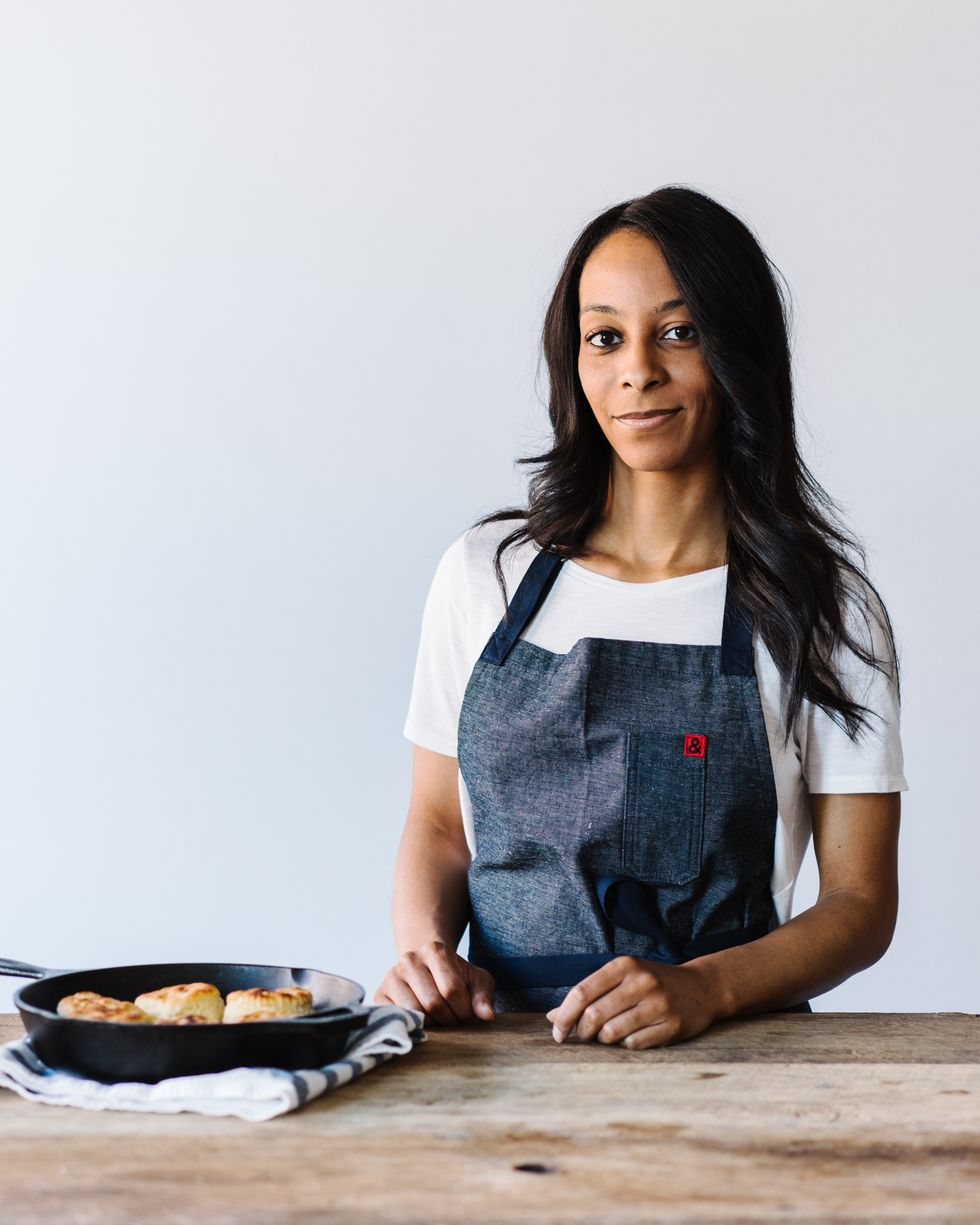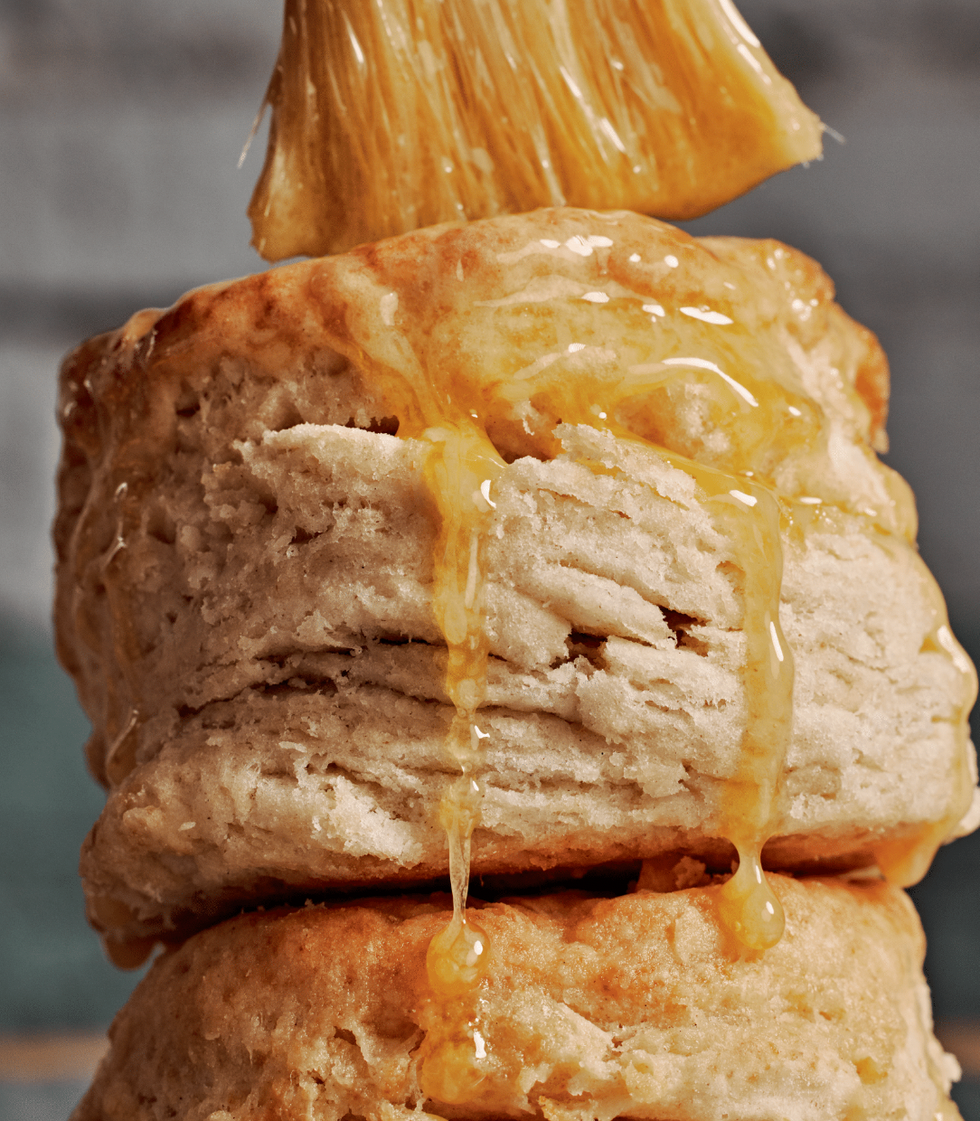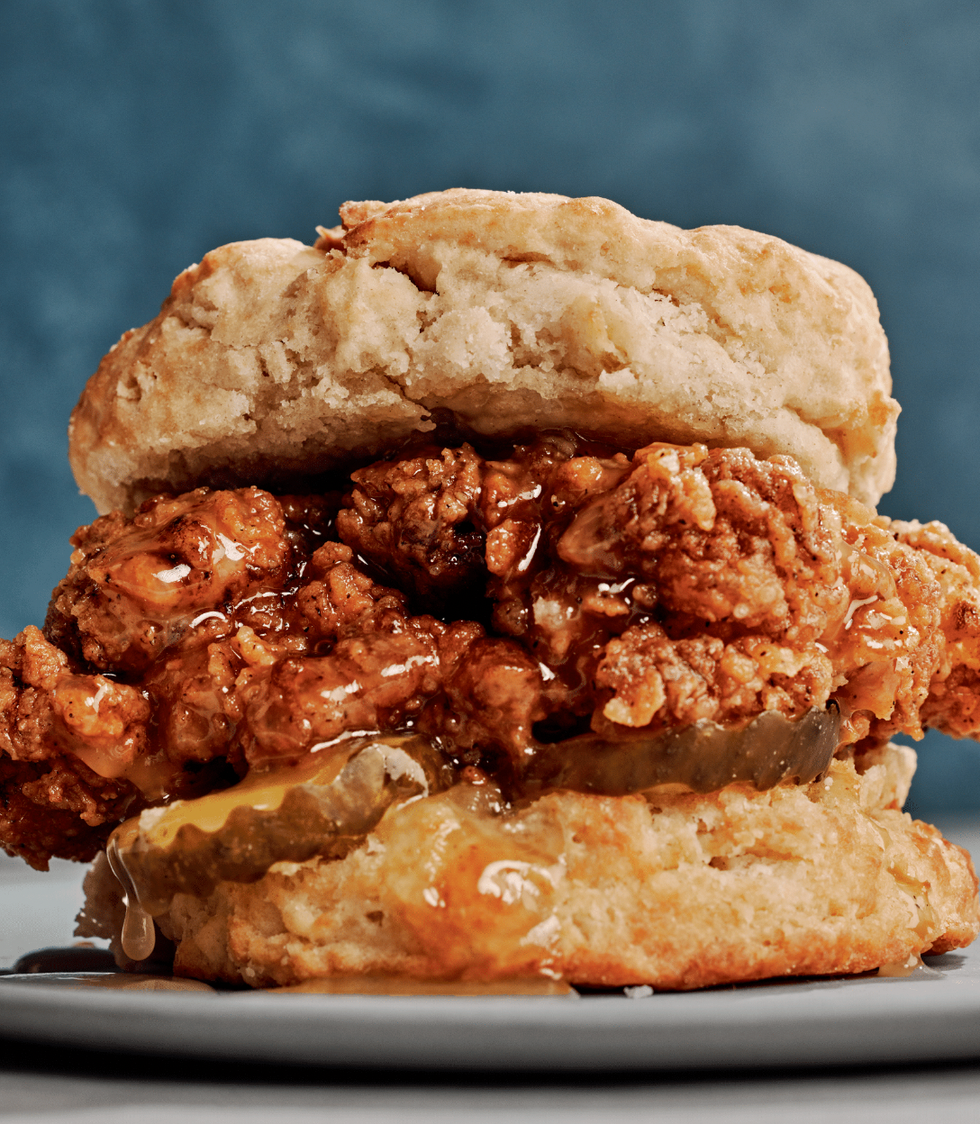
We come across a lot of cookbooks at Brit + Co – food is literally our bread and butter. But once in a while, one really stands out as a bookshelf must. Still We Rise: A Love Letter to Southern Biscuits with Over 70 Sweet & Savory Recipes by Erika Council (Clarkson Potter) is one of those gems.
The granddaughter of legendary soul food chef Mildred (Mama Dip) Council and a teacher and activist who cooked and baked to support the Civil Rights movement, Erika shares stories of community, cooking, and the African American heritage of amazing home cooking.

Owner of Bomb Biscuits in Atlanta, Erika shares recipes for everything from chicken biscuit sandwiches to cinnamon sugar and pecan biscuits to an everything bagel biscuit and more. Score an easy home biscuit mix that you can whip up in minutes too. Here, we chatted with Erika about her creative life in the kitchen, plus she shares recipes with us (and you) below!
Hi Erika! I love the premise for your book. So what makes a great biscuit?
Erika: I definitely think patience. If you move too quickly, you end up over-handling the dough, which makes the biscuits hard. Having a full-fat buttermilk and just good butter helps as well, and just having the right ingredients. Some of the best biscuits I've had were made with no butter at all, it was just lard. A good buttermilk, in my opinion, does a lot of heavy lifting.

How did your grandmothers pave the way for your career?
Erika: On my mom's side, my grandma was an educator, so education was very important. That just propelled me in a direction that I wanted to put education first and be able to be in a position in society where I could help everyone else. And I know you need certain resources to do that, so I definitely wanted to use those resources to better not only my life but my family's and all those who were around us.
You talk about ways in which African American women and men have been often erased from the history of food. How are you helping to give them a voice?
Erika: One thing I always want to hint to is they may not necessarily have been Michelin star chefs, or someone who had a huge restaurant group, but the impact that African Americans had with the food they made and the doors they opened along the way was substantial. It's just very important to me because I am here because of it, not just because I just picked up a book one day and decided I wanted to learn how to make biscuits. I just really saw the whole world and how one operates a business and tries to be an entrepreneur as an African American in the south. When you see things like farm-to-table and fresh ingredients and its overall associations, and while that has changed drastically years now, we see people attributing that more not to just white chefs, it's important for me to be able to say that was all I ever knew. Knowing not a lot of people outside of my mom, who was a single mom, who worked very hard, get to the grocery store. Everything came from a farmer and everything was fresh, so the idea that that's not something that African Americans are exposed to or attributed to, I think I always want to really hone in on how that's not the case.
What is your favorite recipe in the book?
Erika: The chocolate chip biscuits because those are my daughter's favorite. It was definitely her idea, and I just thought it was absolutely mad. She said, "You should roll some chocolate chips in there and make them like cookies," and I was just like, why would I do that? But I did, and they are one of the biggest selling biscuits we have at Bomb Biscuits. There's also one in there that's a s'mores biscuit, and it uses graham flour and we use marshmallow fluff and melted chocolate, so the biscuit is kind of like an elevated chocolate chip biscuit.
In 2016, you were invited as a guest chef for the James Beard Foundation Sunday Supper. What is the significance of the Sunday Supper in African American culture?
Erika: For me, it was my great Aunt Mabel, because she lived in a house that Big Daddy built. We would all go there after church, my cousin, my aunts, and my mom, and even people who weren't necessarily related to us. To me it just felt like, you may have had a week where you didn't have a lot of interaction with your family members, it may not have been the best week, it may have been a great week, but to me, nothing felt better than being around the people who you just felt this warmth with. And so you're sitting at a table, multiple tables, in one house, just surrounded by not just really good food but love.
And then the other side of that was First Sunday at our church. All of the ladies and men of the church who thought they were the best cooks, the best bakers, brought a dish, so when you left the sanctuary, you would head over to the fellowship hall, it just felt like... here's your chance to have this Sunday dinner with the people who you feel the closest to who you're not related to, but it's the whole community.
What is your best biscuit memory?
Erika: It was the first time I tried to make biscuits, and I made them with my granny, and I was so excited thinking that I had really done something and they just were terrible. It burned, and the oil was dripping in the bottom of the oven, the alarm went off... And they were just terrible. And I just remember she sat down after she helped me clean everything up and she ate them...and I remember thinking, wow, you like them? And she said, "No, they're terrible, but we are going to eat... These are the fruits of your labor, you're going to taste it and figure out what you did wrong." And I think that to me has been a memory that I've taken throughout life. Some stuff doesn't turn out the way you want it to, but I just absorb it and evaluate it and figure out what I did wrong.
We love that lesson. Thanks Erika for sharing your story and your biscuits! Bakers and biscuit lovers can now pre-order Still We Rise, which comes out this July. Here are two biscuit recipes from the book to try!

The Bomb Buttermilk Biscuit
YIELD: 6 TO 8 BISCUITS
- 2½ cups / 300 grams all-purpose flour, plus extra for folding and cutting
- 1 tablespoon baking powder
- 1½ teaspoons kosher salt
- ½ teaspoon baking soda
- 2 tablespoons / 27 grams vegetable shortening, cold, cut into ½-inch chunks
- 1 stick (8 tablespoons) unsalted butter, cold
- 1½ cups full-fat buttermilk, cold
1. Adjust the oven rack to the middle position and preheat the oven to 450°F. This rack position is ideal for baking since it situates the biscuits in the middle of the oven, allowing the hot air to circulate around the pan, resulting in even baking.
2. Place the flour, baking powder, salt, and baking soda in a large bowl and whisk to combine. Whisking the dry ingredients ensures they’re evenly distributed. No one wants to bite into a warm biscuit only to find a bitter pocket of baking soda. Whisking also helps to bring air into the flour, making it fluffier and easier to mix with the wet ingredients.
3. Using your fingers, a pastry cutter, or a fork, work the shortening into the flour mixture until only pea-sized pieces remain. Using the slicing side of a box grater, slice the butter into the flour mixture. Toss the sheets of butter in the flour and then lightly work the butter pieces between your fingers or use a pastry cutter to break them up and coat them with flour. Stop when the dough resembles coarse sand and there are still some small visible pieces of butter. Once these pieces of butter melt in the oven, steam will be released and will lift the biscuit, forming tender, flaky layers.
4. Place the biscuit mixture into the freezer for 15 minutes. This helps ensure the butter doesn’t soften too much and that it melts only in the oven to create the layer effect.
5. Add the buttermilk to the chilled flour mixture and stir with a spatula until the dough forms into a ball and no dry bits of flour are visible. The dough will be shaggy and sticky.
6. To avoid adding too much liquid to your biscuit mix, start with half of what the recipe calls for and gradually add in the remaining amount until the dough is almost the consistency of Silly Putty.
7. If you do add too much liquid to the dry ingredients, don’t just “add more flour” as some recipes call for because your biscuits will not rise as they should, since you’ve added more flour but not additional leavening ingredients (baking powder and baking soda). Instead of trying to roll them out the traditional way, grab an ice cream scoop or spoon and make them into drop biscuits.

Glori-Fried Chicken Biscuit Sandwich
YIELD: 4 SANDWICHES
- 1 cup full-fat buttermilk, cold
- 4 tablespoons Texas Pete hot sauce
- 1 tablespoon bread-and-butter pickle juice
- Four 5- to 7-ounce boneless skinless chicken thighs
- ¾ cup / 96 grams self-rising flour
- 2 teaspoons cornstarch
- 1½ teaspoons kosher salt
- 1½ teaspoons Tony Chachere’s seasoning blend (or any Cajun seasoning)
- ½ teaspoon paprika
- ½ teaspoon onion powder
- ½ teaspoon garlic powder
- ½ teaspoon freshly ground black pepper
- Peanut oil, for frying
- 3 tablespoons unsalted butter, melted
- 1 tablespoon honey
- 4 Bomb Buttermilk Biscuits (see recipe above)
- 8 bread-and-butter pickle slices
Saying I make a lot of these biscuits is an understatement. Atlanta loves fried chicken, and I love all y’all that keep coming back for more.Using chicken thighs (dark meat) helps to make sure you don’t serve up dry fried chicken. Nobody likes that. If dark meat is not your thing, I get it and you can switch it out for chicken breast. However, keep in mind that white meat does not take as long to cook as dark, so you will want to check the internal temperature on the chicken a little sooner than the instructions below dictate. A drizzle of honey butter is a heavenly addition to top off the fried chicken; add a little or a lot to suit your preference.
1. Place the buttermilk, hot sauce, and pickle juice in a medium bowl and whisk to combine. Add the chicken thighs and coat thoroughly with the mixture. Cover and refrigerate for 24 hours, tossing occasionally.
2. Using a slotted spoon, remove the chicken from the marinade and set aside to drain slightly.
3. Place the flour, cornstarch, salt, seasoning blend, paprika, onion powder, garlic powder, and pepper in a small bowl and whisk to combine. Dredge the chicken thighs in the mixture, coating them evenly, and set aside. Place a cooling rack over a paper towel–lined baking sheet.
4. In a 6-quart Dutch oven or heavy-bottomed pot over medium high heat, heat 1½inches of oil to 325°F. Gently add 2of the chicken thighs and cook until golden brown and the internal temperature is 165°F, 6 to 7minutes, turning over halfway through. Transfer the cooked chicken to the cooling rack and repeat with the remaining 2 chicken thighs.
5. Place the melted butter and honey in a small bowl and whisk to combine.
6.Cut the biscuits in half and reheat if necessary (see Cook’s Note). To build the sandwich, place 2 pickles on each biscuit bottom, top with the chicken thighs, and drizzle each sandwich evenly with the honey butter mixture. Cover with the biscuit tops and serve immediately.
Cook’s Note: If you are not making the sandwiches the same day, brush the cut biscuits with melted butter and reheat, cut side down, in a skillet or sauté pan over medium heat for 1to 2 minutes.
Recipes and images courtesy of Still We Rise: A Love Letter to Southern Biscuits with Over 70 Sweet & Savory Recipes by Erika Council (Clarkson Potter)
Sign up for our newsletter for more delicious baking recipes!
